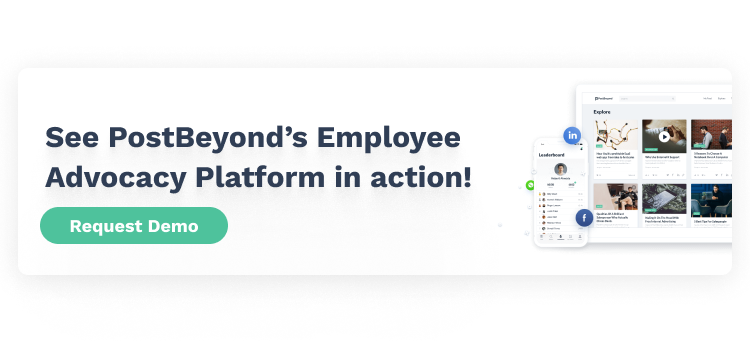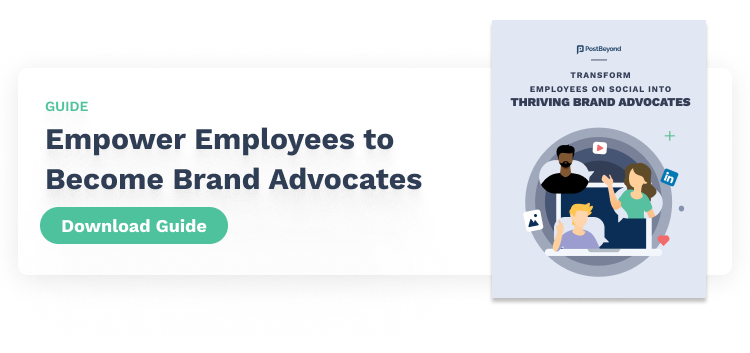If you’re looking to drive pipeline growth on LinkedIn, you’ll need these social selling tips.
Why?
We’re in an age where audiences don’t want to see or hear from brands. It’s nothing personal, but people just don’t want to be sold to.
Us marketers know this because we blast LinkedIn DMs with a sales pitch or demo offer. Yet, with each passing day, we’re seeing fewer people respond. From cold outreach to paid ads, traditional marketing tactics are getting harder – and costlier – to leverage.
However, your target audience does want to hear from you, but in your capacity as a problem-solver, not as a seller. And, when we say “you”, we literally mean you!
People don’t care for brands or logos, but rather, they follow the lead of other people. This is why influencers, brand ambassadors, customer advocates, and employee advocates are the ones leading conversations and driving narratives on social.
A Nielsen study, for example, found that 88% of audiences say they “trust recommendations from people they know more than any other channel.”
Just think about your own LinkedIn feed. When you scroll, how many times do you stop and read what a brand has to say compared to someone you see as a thought leader? Where do you see most of the conversations happening? On a brand page, or someone else’s profile?
This is where social selling comes into play. When done right, social selling equips you, your teams, and your brand to drive pipeline growth in today’s audience-first, customer-led buyer’s journey. Who better to give us social selling tips than the folks who leaned on social selling to grow their business – i.e. Laura Erdem and Steffen Hedebrandt from Dreamdata.
What is Social Selling?

Social selling is a strategy of using social media platforms to connect with sales leads/prospects where those leads/prospects engage you as a credible problem-solver, not a sales rep.
It’d be a mistake to reduce social selling to just getting your sales team to reach out to prospects through social media. That’s just outreach through social, not social selling.
In fact, Steffen emphasized that the goal of Dreamdata’s social selling strategy is to get “people to come to us rather than for us to push through.”
Social selling is about elevating the individuals in your sales team into thought leaders, subject matter experts, and leaders. You want to reach a point where if a person has a problem, they’ll reach out to your sales team for help.
When you establish that kind of connection with a prospect, you have much more than just their attention. You have their earnest desire to solve a problem using the solution you provide. That is the sales prospect that has a better chance of closing than someone you have to spend time convincing without any prior context or groundwork.
In terms of getting that point, Laura and Steffen shared with us their social selling tips:
7 Social Selling Tips for 2023

1. Post More Than You “Pitch”
For his first social selling tip, Steffen told us to “post more than we pitch.”
Basically, approach social from the angle of providing value through your posts, comments and shares. If someone in your network asks a question, see if you can offer an answer. If you see a discussion, join in the comments with your own insights.
Whether it’s you or someone else in your company, it’s absolutely vital that you lean on two key aspects of you: (1) your credibility and (2) your authenticity.
Your credibility reflects your knowledge and expertise. It’s the input that provides tangible value (like tips, insights, etc) to your network. Your authenticity are qualities that make you relatable, build trust, and build relationships with potential customers.
Yes, the strategic goal of social selling is to drive pipeline. But in your capacity as an individual posting on social media, focus on credibility and authenticity. When these two aspects shine in your content, you’ll build the audiences and, with time, pull prospects towards you.
2. Take a Crawl, Walk and Run Approach to Social
Okay, we know that posting on social matters, but when do we start?
Well, there’s no excuse not to start. You don’t have to be a veteran social media rockstar from day one (but there’s nothing wrong with pulling that off!).
If you or the people on your team don’t know where to start, then just kick things off with simpler and less intense tasks. Start with regularly Liking your colleagues’ posts. Consider commenting on other people’s profiles. Once you’re ready, write your own posts.
With this social selling tip, Laura recommends you just start and be consistent.
Laura shared how consistency made her better. Her earliest posts weren’t her best, but she learned from them. No one remembers you or your company on social. If your post wasn’t all that great, then don’t worry, no one will remember it! Just keep moving forward.
You can also help your wider team with their social selling efforts by making content (such as blog posts, guides, memes, videos, etc) available to share.
This way, everyone has a starting point (i.e., a link or asset) to get their feet wet. But if you work with the team to build content, especially with their expertise, then those same people could one day speak to it with their original commentary and insights.
3. Don’t Reach for Perfection. Don’t be Scared of Failing
As Laura said, “no one cares about you or your company.” No one will remember a post that didn’t quite “hit” the mark. However, don’t be discouraged by a lack of overt engagement.
One of the cool things Steffen and Laura brought up was how they had prospects who’d read their content, but never overtly react to it with a Like or comment.
The key with this social selling tip is to really work on improving your LinkedIn posts. There are many techniques you can use to drive more exposure and engagement. Use our guide on posting on LinkedIn and start incorporating them into your social media strategy.
4. Social Selling is a ‘One-to-Many’ Strategy
Laura discussed how in traditional sales strategies you’d approach prospects through a one-to- one conversation. This approach continues to this day, especially through cold outreach. But in social selling, you’re taking a ‘one-to-many’ strategy where how people perceive you matters.
You want your audience – especially your prospects – to see you as a thought leader.
Study the problems your prospects are facing in their day-to-day work. Bring up those problems with your LinkedIn network and discuss solutions from the angle of a problem-solver. You could start by commenting or even writing original posts.
Sync with your marketing team to get relevant content out of the gate. You may not be able to build certain assets (like a comparison chart, step-by-step guide, etc) alone. But you do have dead-on insights about your prospects’ pain points. Get that information in front of the content marketing team to produce assets that will resonate with your audiences.
Once you “leave your mark”, as Laura put it, you’ll be able to start pulling your conversations back to the ‘one-on-one’ realm when the time is right.
5. Adapt to the ‘New Buyer’s Journey’

Today’s buyers don’t neatly fall into the traditional stage of the buying process. In fact, today, most will pick up on when they’re being guided into a certain path in your funnel.
Moreover, buyers have gotten really good at tuning information out. The first ones people go blind to are brands. In fact, when it comes to getting the information that really matters, today’s buyers will actually look to other sources, like your existing customers.
Don’t stress about where your social selling content ‘sits in the funnel’. Rather, focus on and respond to the actual pain points you’re seeing from your audience. Check out our guide on social listening to start generating visibility of these pain points.
The point of this social selling tip is to be creative and use as many different types of content and assets to drive the conversation.
6. Get Your Team to Engage on Social
Overall, an effective social selling strategy would involve your wider team or company, not just your sales and marketing teams.
Just think about the best-case scenario. A prospect reaches out to you for a solution. They trust your sales rep, but what about the other people in your company they’ll need to work with, such as your customer success team, product team, and engineering or development team. You want prospects to feel that they’re leaving their business to experts who love their users.
7. Involve Your Customers
There’s no better source for vetting your product or service than your existing customers. To the buyer or prospect, your customers are key sources of social proof.
This is obvious when it comes to references or feedback. But it can work in your favor in other ways too. Let’s say your customer is a thought leader, the prospect could ask them for help or tips. Imagine the boost you’d get if the customer brings up your solution in a positive light, or refers the prospect to speak to you.
The world of customer marketing and advocacy will open the door to mobilizing the voices of your customers in impactful ways.
Social Selling Leans on Your Employees
Be it your sales people (who’d spearhead your program) to your wider company (who can help with driving more reach and exposure), you need your employees on social media. But getting – and keeping – them on social media isn’t easy, especially when you involve more people.
This is where a formal employee advocacy program can help you carry your social selling efforts in a scalable and efficient way.







